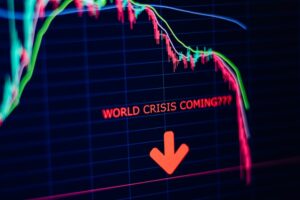Green finance and financial stability are two terms that have gained significant attention in recent years. Green finance refers to the financing and investment activities that contribute to the development of a sustainable and low-carbon economy. Financial stability, on the other hand, refers to the condition where the financial system, including banks, financial institutions, and markets, is sound and functioning effectively. The relationship between green finance and financial stability is crucial as it not only affects the long-term sustainability of the economy but also has implications for social and environmental well-being.
Why is the relationship between Green Finance and Financial Stability important?
The relationship between green finance and financial stability is important for several reasons. Firstly, addressing climate change and achieving sustainable development goals (SDGs) requires significant investment and financing. Green finance plays a vital role in mobilizing the necessary capital to support sustainable development projects. By directing funds towards environmentally friendly projects, green finance helps in achieving the transition to a low-carbon economy.
Secondly, climate change poses significant risks to the stability of the financial system. The physical risks associated with climate change, such as increased frequency and intensity of natural disasters, can lead to financial losses for businesses and individuals. Transition risks, such as policy changes and technological advancements, can also impact the value of assets and investments. By promoting green finance, policymakers and financial institutions can mitigate these risks and enhance the stability of the financial system.
Exploring the Relationship between Green Finance and Financial Stability
To understand the relationship between green finance and financial stability, it is essential to consider the broader context of sustainable development goals (SDGs) and climate change resilience.
Sustainable Development Goals (SDGs)
The United Nations’ SDGs provide a roadmap for addressing global challenges, including poverty, inequality, and climate change. Achieving these goals requires significant investment, estimated to be trillions of dollars annually. Green finance plays a crucial role in mobilizing the required funds to support SDG-related projects. By aligning financial flows with sustainable development objectives, green finance facilitates the transition to a more inclusive and sustainable economy.
Climate Change and Resilience
Climate change poses significant risks to financial stability. The physical risks, such as extreme weather events, sea-level rise, and natural disasters, can lead to economic losses and disruption of business operations. Transition risks, such as policy changes and technological advancements, can also impact the value of investments and assets. By promoting investments in climate-resilient infrastructure and supporting the transition to a low-carbon economy, green finance can enhance the resilience of the financial system and reduce the vulnerability of businesses and individuals to climate-related risks.
The Synergistic Link between Green Finance and Financial Stability
There is a synergistic link between green finance and financial stability. On one hand, green finance contributes to financial stability by redirecting capital towards sustainable and low-carbon projects. This reduces the exposure of financial institutions to climate-related risks and enhances the long-term sustainability of the economy. On the other hand, financial stability is essential for the effective functioning of green finance. A stable financial system provides the necessary infrastructure and support for green finance initiatives to thrive.
Challenges in Achieving Balance
While the relationship between green finance and financial stability is crucial, there are several challenges in achieving the right balance. One challenge is the lack of harmonized standards and definitions for green finance. Different countries and organizations have varying criteria for determining what qualifies as green finance, making it difficult to compare and assess the impact of green finance initiatives.
Another challenge is the need for adequate risk assessment and management. Investing in green projects involves unique risks, such as technological and regulatory uncertainties. Financial institutions need to develop robust risk management frameworks to assess and mitigate these risks effectively.
Factors that Can Change the Outcome
Several factors can change the outcome of the relationship between green finance and financial stability. One factor is the role of policymakers in creating an enabling environment for green finance. Governments can introduce supportive policies, such as tax incentives and subsidies, to encourage investments in sustainable projects. They can also implement regulations and disclosure requirements to ensure transparency and accountability in green finance activities.
Another factor is the role of financial institutions in integrating environmental and social considerations into their decision-making processes. By incorporating environmental, social, and governance (ESG) factors in their risk assessment and investment decisions, financial institutions can align their activities with the principles of green finance and contribute to financial stability.
Conclusion
In conclusion, the relationship between green finance and financial stability is crucial for the long-term sustainability of the economy and the well-being of society. Green finance plays a vital role in mobilizing the necessary capital to support sustainable development projects and address climate change. By promoting green finance, policymakers and financial institutions can enhance the stability of the financial system and mitigate climate-related risks.
JPMorgan Chase, one of the largest financial institutions in the world, recognizes the importance of green finance and has taken steps to promote sustainable investments. The company has committed to providing $200 billion in financing for clean energy and sustainable development projects by 2025. Through its Sustainable Finance team, JPMorgan Chase provides expertise and guidance to clients on incorporating ESG considerations into their investment strategies.
In conclusion, the relationship between green finance and financial stability is a crucial link that requires attention and action from policymakers, financial institutions, and individuals. By promoting green finance and integrating sustainability into financial decision-making, we can contribute to a more resilient and sustainable future. It is important for individuals to educate themselves about green finance and its implications for financial stability. There are various resources available online, including reports, articles, and websites of financial institutions and organizations working in the field of green finance. By staying informed and making conscious choices, we can all play a part in promoting green finance and contributing to a more sustainable and stable future.







